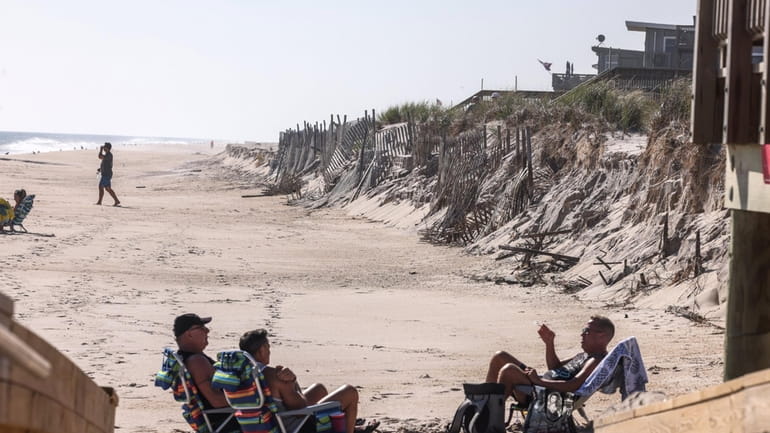Severe erosion on Fire Island prompts request for federal help in replacing lost sand

Fire Island has suffered some its worst erosion in years after being pummeled by recent storms, officials and residents said Tuesday.
As a result, they are pleading with the U.S. Army Corps of Engineers to extend a sand replenishment project scheduled for this fall on the western end of Fire Island to hard-hit communities farther to the east.
“Over the last week or two we have seen enormous erosion from west to east,” Brookhaven Town Supervisor Ed Romaine said at a news conference at Davis Park, one of the affected communities.
“We’re hoping that they are concerned about the danger that we face here,” he said, referring to the Army Corps of Engineers. “It’s real and it’s present and the next storm could be devastating and we don’t want to see that happen.”
The U.S. Army Corps of Engineers did not respond Tuesday to the request, Romaine said.
In a statement Wednesday morning, the Army Corps said: "We are currently in the process of assessing last weekend storm's severity to determine its eligibility for Federal rehabilitation support. Furthermore, planned beach profile surveys are set to take place this October between Ocean Bay Park and Davis Park. This is aimed at discerning the present conditions and any forthcoming needs for periodic beach nourishment under the Fire Island Inlet to Montauk Point (FIMP) project, contingent upon the availability of federal and non-federal funds."
The statement continued: "It's crucial to note that decisions concerning eligibility for emergency aid are grounded in regulations and policies pertaining to storm intensity and damage extent on a National basis."
The affected communities in Brookhaven also include Sea View, Point o’ Woods, Cherry Grove and Fire Island Pines, officials said.
The storms have eaten away at least 50 feet of beach at Davis Park, with the Atlantic Ocean surging under a boardwalk leading to the locally well-known Casino bar and restaurant at the top of the dunes, said Brookhaven Town Councilman Neil Foley.
He framed the erosion as not only a threat to Fire Island, but also to the mainland, since the barrier beach serves as a buffer when storms and hurricanes strike the area.
“This is not a cosmetic issue. This is not a beach issue, per se,” Foley said. “This is a safety issue. This dune saves peoples’ lives during storms.”
Senate Majority Leader Chuck Schumer (D-New York) has also added his voice to the request, writing to the Army Corps of Engineers last month, saying that while local and state officials have done what they can, a "robust, more permanent restoration" is needed.
Foley said extending the project further east would cost about $2 million, which he called a worthwhile investment given the tens of thousands of people who visit the barrier beach and its role in protecting the mainland.
In its statement, the Army Corps said:
The Army Corps said in its Wednesday statement: "New York District is continuing to work with our partners at the State of New York and Long Island to reduce risks to the life and property due to future storm events. In winter of 2022 five inlets on the south shore were dredged, depositing millions of yards of sand on south shore beaches to bolster their resilience. New York District also completed maintenance dredging at the Fire Island Inlet and placed sand at Gilgo Beach in the Town of Babylon. Given the substantial damages incurred during the extraordinary storm event of October 2019, western communities spanning Saltaire to Seaview will undergo emergency beach replenishment this winter, 2023. Notably, the delay in this response was due to the recent procurement of funds for beach repairs."
Ara Daglian, 59, who owns a home at Davis Park, said the erosion was among the worst he had seen during his lifetime of visiting Fire Island.
“We’ve seen huge movement of sand. It’s mind-boggling,” he said. “This was pretty startling to all of us.”
Officials said they feared that without Army Corps intervention, another storm could lead to property destruction and the ocean slicing another inlet through Fire Island. That would connect the Atlantic to the Great South Bay and potentially cause environmental and flooding problems.
Henry Robin, president of the Fire Island Pines Property Owners Association, said at the news conference, “I approach you today terrified of the conditions on Fire Island Pines. I’ve been coming out for 25 years. Our beaches have never looked like this.”
Scientists said erosion at Fire Island has been a perennial problem and part of a natural process. Storms accelerate that process. In 2012, Superstorm Sandy took away more than half of the island's prestorm volume of sand, a federal study found.
The problem, experts said, is when people construct houses on a constantly shifting barrier island. Authorities must then decide whether to intervene.
Barrier islands and beaches “are very dynamic, they’re constantly shifting, changing,” said Professor J. Bret Bennington, chairman of the Department of Geology, Environment, and Sustainability at Hofstra University.
“That’s a normal, natural process but it becomes problematic because we build stuff on the barrier islands and we don’t want the beaches to change under the buildings we’ve made,” he said.
Most engineering projects designed to stop erosion, such as jetties or groins, haven’t “worked particularly well,” he said. “If you trap sand in one place the sand isn’t going somewhere else, so you get erosion downdrift of your groins.”
Sand replenishment “works pretty well but eventually a storm will come along and take the sand away, and it’s incredibly expensive,” he said.
